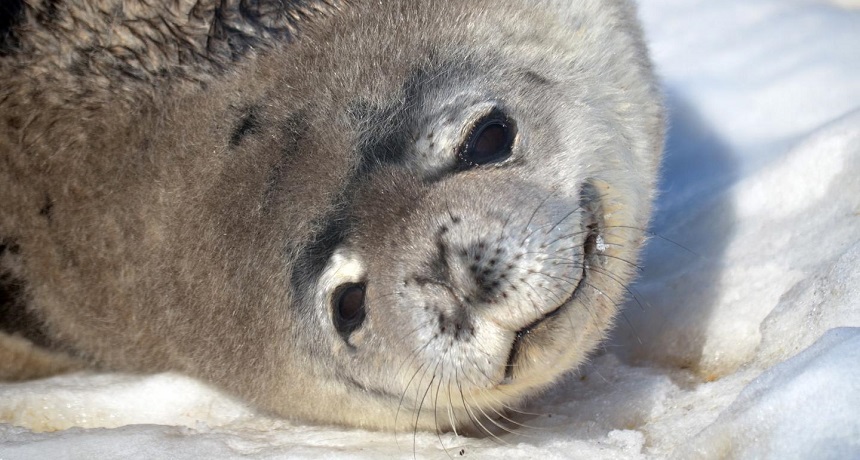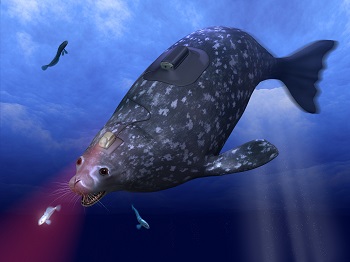Resilient hearts for deep-sea divers
A new instrument package gives insights into how diving mammals can perform so much hard work while holding their breaths for a really long time

New research sheds light on how mammal species, like this Antarctic seal, can pull off amazing feats while holding their breath underwater.
Peter Rejcek, National Science Foundation
Many of us struggle to hold our breath for a minute. It’s not unusual, however, for seals and other marine mammals to take hour-long plunges underwater — and swim pretty fast during that time. How do these deep-diving mammals pull it off? It’s not as straightforward as biologists had thought, a new study shows.
Diving mammals have a few physiological tricks that help them stay underwater for much longer than people can. First, they can hold more oxygen in their blood and muscles. It’s like having an internal scuba tank.
And to make the oxygen in their “tanks” last longer, their hearts can slow down — way down. In the 1930s, scientists discovered that when a seal goes underwater, its heart beat — also known as heart rate — can plummet to a mere four or five beats per minute! By comparison, a doctor would panic if your pulse dropped below 30.
But no one knew how reliable those early experiments were. The test conditions were artificial. Researchers brought seals into the lab, dunked each animal’s head into a tub of water and measured its heart rate. What scientists really wanted to know, though, was how marine mammals might adjust their heart activity in the wild — when taking a playful dip, for example, or diving for food.
The scientists also recognized a puzzle: When people sprint or bike or otherwise work up a sweat, their heart rate skyrockets. By pumping more frequently, the heart can send more oxygen to muscles. One would expect this same “exercise response” in sea mammals. After all, when a hungry seal takes a plunge, it swims vigorously to catch its next meal. But it would seem that the animal’s heart rate must remain low if it is to spend an hour or more underwater and not use up all the oxygen in its lungs and blood. Lowering its heart rate is part of that seal’s “dive response.” So which wins out — the dive response or exercise response?
To find the answer, Terrie Williams and her team studied bottlenose dolphins and Weddell seals, a seal species common in Antarctica. “We wanted to know what happens [to their heart rate] when they dive to different depths, and what happens when they exercise,” Williams explained to Science News for Students. Williams is an animal physiologist. She works at the University of California, Santa Cruz.

The researchers glued the instrument to a piece of synthetic rubber, then attached that to the animal’s skin. The instrument monitored the animal’s heart rate. It also recorded how deep it plunged and how fast it stroked its flippers. Scientists had made some of these measurements before, but never all at once on an animal in the wild.
For the seal data, the scientists trekked to the coldest, driest place on Earth: Antarctica. Besides the sheer adventure of braving white desolation and temperatures of -10° to -30° Celsius (14° to -22° Fahrenheit), there are practical reasons for studying seals at the bottom of the Earth. Because much of the ocean’s surface there is frozen, seals can haul out only at large cracks and holes in the ice, Williams notes. Using satellite and radio tags attached to the seals, the researchers can locate where the animals haul out and then collect their instruments and data.
Fortunately, despite being huge — about as big as a grizzly bear — Weddell seals are “mild-mannered and easy to work with,” Williams told Science News for Students. Still, it was not a piece a cake. The time it takes to find a seal, bring it back to camp and dry its fur to attach the instruments — “that’s a good chunk of your day right there,” she explains.
In all, the researchers monitored three seals as they made a total of 91 dives. As shown in previous work by Williams and others, the animals’ heart rate dropped sharply during dives. However, a closer look at the numbers turned up something new. How deep the animals dove and how rapidly they swam influenced how much the animal’s heart rate slowed.
The heart beat much more slowly in deep waters and not quite that slowly during active swimming. In other words, ocean depth and exercise appeared to have competing effects on heart activity. Williams’ team published its findings January 16 in Nature Communications.
“The approach in and of itself is quite a leap forward,” says Frank Fish. “They’re getting all these pieces of information nicely correlated with each other over time.” A biologist at West Chester University in Pennsylvania, Fish studies the biomechanics of aquatic mammals.
Dolphins too
Collecting the data wasn’t easy. “Trying to retrieve instruments on marine mammals in the open ocean is like finding a needle in a haystack,” Williams says. “We couldn’t just put [the tags] on wild dolphins because they’re too fast and could go anywhere.”
But that didn’t keep the team from working with dolphins. The scientists just had to adapt, altering where they studied them.
The researchers recruited bottlenose dolphins that had been trained to dive and swim through hoops submerged in saltwater pools or in the open ocean. The team recorded shallow 3- to 10-meter (10- to 33-foot) dives made by dolphins in a marine lab at the University of California, Santa Cruz, and at the Epcot theme park in Florida. The researchers also monitored dolphins in Hawaii and the Bahamas as they made open-water dives to depths of 210 meters (690 feet).
In all, the team collected data from 10 animals during 74 different dives. The slowed heart rate showed up in these animals too.
Flip-flopping heart rate
Analyses of the dolphins’ and seals’ deep dives revealed a stunning new pattern of dramatically varying heart rates. An animal’s heart rate might slow down, then speed up, only to slow down again and later speed up again. This flip-flopping often sent an animal’s heart into arrhythmia — a condition where it beats erratically.
Researchers aren’t sure if the arrhythmias risk harm to the deeply diving mammals. In some ways, the rapid changes in heart rate among diving mammals could be seen as “an amazing ability,” Fish says.
To put things into human perspective, consider this: When a person runs on a treadmill, her heart pumps faster. This boosts the blood supply and sends more oxygen to her leg muscles. When she hops off the treadmill, her heart rate slows back to its resting level. However, “it takes a while,” Fish says. “We can’t bring our heart rate down and then bring it up suddenly and back down again. Yet marine mammals can slow down their heart as quickly as they speed it up.”
Sascha Hooker agrees that the current study shifts biologists’ general understanding of how diving mammals operate in the ocean, especially at depths. A biologist at the University of St. Andrews in Scotland, Hooker studies the foraging behavior of marine predators. While these animals “display a range of adaptations that help them to dive for long periods and to great depths,” she says, “the new research suggests that things aren’t quite as black and white as we might like to think.” Simply put: They’re complicated.
Power Words
(For more about Power Words, click here)
arrhythmia An altered, usually erratic pattern in a normal rhythm, such as the pace of an individual’s heartbeats. A persistent, untreated heart arrhythmia can prove very dangerous.
biology The study of living things. The scientists who study them are known as biologists.
biomechanics The study of how living things move, especially of the forces exerted by muscles and gravity on the skeletal structure.
bottlenose dolphin A common species of dolphin (Tursiops truncate), which belongs to the order Cetacea among marine mammals. These dolphins are found all over the world.
correlation A mutual relationship or connection between two variables. When there is a positive correlation, an increase in one variable is associated with an increase in the other. (For instance, scientists might correlate an increase in time spent watching TV with an increase in risk of obesity.) Where there is an inverse correlation, an increase in one value is associated with a decrease in the other. (Scientists might correlate an increase in TV watching with a decrease in time spent exercising each week.) A correlation between two variables does not necessarily mean one is causing the other.
erratic A pattern that appears irregular and unpredictable.
forage To search for something, especially food.
heart rate Heart beat; the number of times per minute that the heart — a pump — contracts, moving blood throughout the body.
mammal A warm-blooded animal distinguished by the possession of hair or fur, the secretion of milk by females for feeding the young, and (typically) the bearing of live young.
marine Having to do with the ocean world or environment.
oxygen A gas that makes up about 21 percent of the atmosphere. All animals and many microorganisms need oxygen to fuel their metabolism.
physiology The branch of biology that deals with the everyday functions of living organisms and how their parts function.
predator (adjective: predatory) A creature that preys on other animals for most or all of its food.
radio To send and receive radio waves; or the device that receives these transmissions.
species A group of similar organisms capable of producing offspring that can survive and reproduce.
tagging (in biology) Attaching some rugged band or package of instruments (tag) onto an animal. Sometimes this tag is used to give each individual a unique identification number. Once attached to the leg, ear or other part of the body of a critter, it can effectively become the animal’s “name.” In some instances, a tag can collect information from the environment around the animal as well. This helps scientists understand both the environment and the animal’s role within it.







